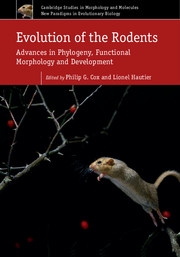Book contents
- Frontmatter
- Contents
- List of contributors
- Foreword
- 1 Rodentia: a model order?
- 2 A synopsis of rodent molecular phylogenetics, systematics and biogeography
- 3 Emerging perspectives on some Paleogene sciurognath rodents in Laurasia: the fossil record and its interpretation
- 4 Phylogeny and evolutionary history of hystricognathous rodents from the Old World during the Tertiary: new insights into the emergence of modern “phiomorph” families
- 5 The history of South American octodontoid rodents and its contribution to evolutionary generalisations
- 6 History, taxonomy and palaeobiology of giant fossil rodents (Hystricognathi, Dinomyidae)
- 7 Advances in integrative taxonomy and evolution of African murid rodents: how morphological trees hide the molecular forest
- 8 Themes and variation in sciurid evolution
- 9 Marmot evolution and global change in the past 10 million years
- 10 Grades and clades among rodents: the promise of geometric morphometrics
- 11 Biogeographic variations in wood mice: testing for the role of morphological variation as a line of least resistance to evolution
- 12 The oral apparatus of rodents: variations on the theme of a gnawing machine
- 13 The muscles of mastication in rodents and the function of the medial pterygoid
- 14 Functional morphology of rodent middle ears
- 15 Variations and anomalies in rodent teeth and their importance for testing computational models of development
- 16 The great variety of dental structures and dynamics in rodents: new insights into their ecological diversity
- 17 Convergent evolution of molar topography in Muroidea (Rodentia, Mammalia): connections between chewing movements and crown morphology
- 18 Developmental mechanisms in the evolution of phenotypic traits in rodent teeth
- 19 Diversity and evolution of femoral variation in Ctenohystrica
- 20 Morphological disparity of the postcranial skeleton in rodents and its implications for palaeobiological inferences: the case of the extinct Theridomyidae (Rodentia, Mammalia)
- Index
- References
10 - Grades and clades among rodents: the promise of geometric morphometrics
Published online by Cambridge University Press: 05 August 2015
- Frontmatter
- Contents
- List of contributors
- Foreword
- 1 Rodentia: a model order?
- 2 A synopsis of rodent molecular phylogenetics, systematics and biogeography
- 3 Emerging perspectives on some Paleogene sciurognath rodents in Laurasia: the fossil record and its interpretation
- 4 Phylogeny and evolutionary history of hystricognathous rodents from the Old World during the Tertiary: new insights into the emergence of modern “phiomorph” families
- 5 The history of South American octodontoid rodents and its contribution to evolutionary generalisations
- 6 History, taxonomy and palaeobiology of giant fossil rodents (Hystricognathi, Dinomyidae)
- 7 Advances in integrative taxonomy and evolution of African murid rodents: how morphological trees hide the molecular forest
- 8 Themes and variation in sciurid evolution
- 9 Marmot evolution and global change in the past 10 million years
- 10 Grades and clades among rodents: the promise of geometric morphometrics
- 11 Biogeographic variations in wood mice: testing for the role of morphological variation as a line of least resistance to evolution
- 12 The oral apparatus of rodents: variations on the theme of a gnawing machine
- 13 The muscles of mastication in rodents and the function of the medial pterygoid
- 14 Functional morphology of rodent middle ears
- 15 Variations and anomalies in rodent teeth and their importance for testing computational models of development
- 16 The great variety of dental structures and dynamics in rodents: new insights into their ecological diversity
- 17 Convergent evolution of molar topography in Muroidea (Rodentia, Mammalia): connections between chewing movements and crown morphology
- 18 Developmental mechanisms in the evolution of phenotypic traits in rodent teeth
- 19 Diversity and evolution of femoral variation in Ctenohystrica
- 20 Morphological disparity of the postcranial skeleton in rodents and its implications for palaeobiological inferences: the case of the extinct Theridomyidae (Rodentia, Mammalia)
- Index
- References
Summary
Introduction
The various mammalian groups, rodents in particular, have developed a wide trophic range shown first and foremost by a significant morphological differentiation of the masticatory apparatus (skull, mandible, teeth and musculature). The mammalian masticatory apparatus is a highly plastic region of the skull, which explains why the associated features are frequently used as diagnostic phylogenetic attributes. In the first place, studying this masticatory apparatus requires precise knowledge of the extent to which its associated morphological features vary. It is only afterwards that one can focus on the factors most likely to have influenced its morphological evolution. Among mammals, the radiation of rodents constitutes a special case. Rodents are considered to be one of the great successful groups in the evolutionary history of mammals, and few mammal clades have been studied as extensively as the order Rodentia. The modern representatives of the order, around 2200 species, are spread across every continent barring Antarctica (Wilson and Reeder, 2005). Their fossil record is very rich, which makes rodents an unavoidable biostratigraphic tool for Paleogene and Neogene deposits.
Justifying the choice of a “rodent” model in a study of evolutionary biology is therefore easy, as it allows the integration of study results in such varied fields as palaeontology, anatomy, ecology or development. Although intensively studied, the phylogenetic relationships between the different groups of rodents have been a matter of debate for over 150 years. While exceptional for an intense diversification of lineages, all rodents share one of the most extreme specializations of the masticatory apparatus characterized by the reduction of the upper and lower incisor series to a single pair. This diprotodonty (i.e. single pairs of upper and lower incisors highly specialized for gnawing) is a hallmark of the rodent masticatory apparatus and is accompanied by a reduction of the number of cheek teeth in association with the development of anteroposterior movements of the mandible for gnawing and chewing (Becht, 1953).
- Type
- Chapter
- Information
- Evolution of the RodentsAdvances in Phylogeny, Functional Morphology and Development, pp. 277 - 299Publisher: Cambridge University PressPrint publication year: 2015
References
- 17
- Cited by

